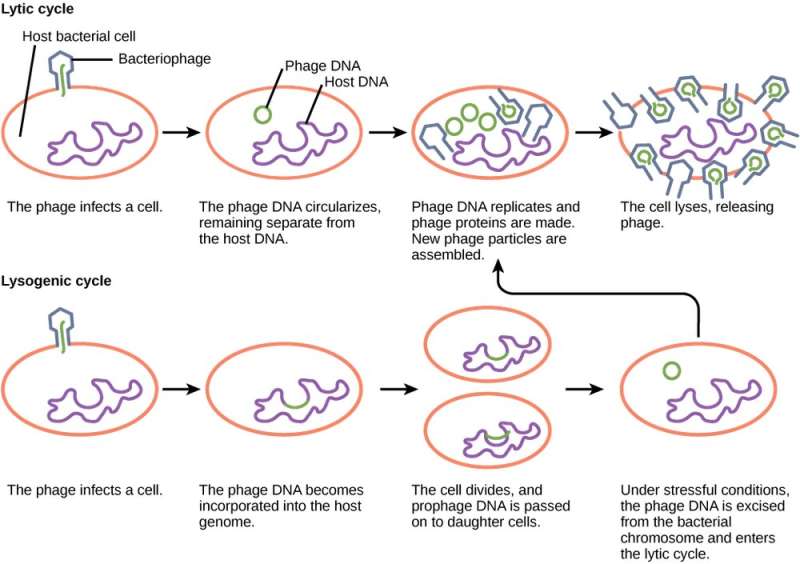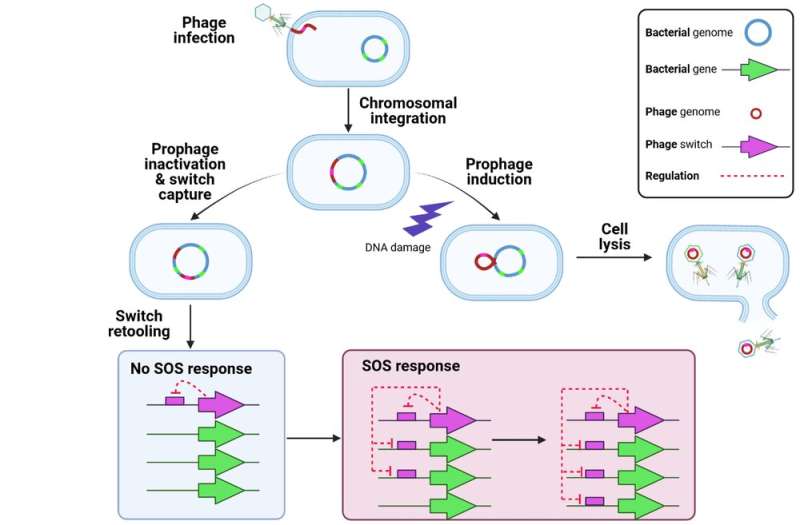Viruses are both the villains and heroes of life as we know it

Viruses have a bad reputation. They are responsible for the COVID-19 pandemic and a that have plagued humanity since time immemorial. Is there anything to celebrate about them?
Many believe there is, at least for one specific type of virus�£���������, , or viruses that infect bacteria. When the DNA of these viruses is captured by a cell, it may contain instructions that enable that cell to perform new tricks.
The mighty power of bacterial viruses
Bacteriophages, or phages for short, keep bacterial populations in check, both on land and at sea. They kill , helping control .
Their ability to selectively kill bacteria also has medical doctors excited. Natural and engineered phages have been that do not respond to antibiotics. This process, known as , could help fight .
points to another important function of phages: They may be nature's ultimate genetic tinkerers, crafting novel genes that cells can retool to gain new functions.
Phages are the most abundant life form on the planet, with at any moment. Like all viruses, phages also have , meaning they form many variants with different characteristics each time they reproduce.
Most phages have a that is filled with their genetic material. In many cases, the shell has more space than the phage needs to store the DNA essential for its replication. This means that phages have room to carry extra genetic baggage: genes that are not actually necessary for the phage's survival that it can modify at will.
How bacteria retooled a viral switch
To see how this plays out, let's take a deeper look at the phage life cycle.
Phages come in two main flavors: temperate and virulent. , like many other viruses, operate on an invade-replicate-kill program. They enter the cell, hijack its components, make copies of themselves and burst out.
, on the other hand, play the long game. They fuse their DNA with the cell's and may lay dormant for years until something triggers their activation. Then they revert to virulent behavior: replicate and burst out.
Many temperate phages use DNA damage as their trigger. It's sort of a "Houston, we have a problem" signal. If the cell's DNA is being damaged, that means the DNA of the resident phage is likely to go next, so the phage wisely decides to jump ship. The genes that direct phages to replicate and burst out are turned off unless DNA damage is detected.
Bacteria have retooled the mechanisms controlling that life cycle to generate a complex genetic system that my collaborators and I have been .
Bacterial cells are also interested in knowing if their DNA is getting busted. If it is, they activate a set of genes that attempt to repair the DNA. This is known as the because, if it fails, the cell is toast. Bacteria orchestrate the SOS response using a switch-like protein that responds to DNA damage: It turns on if there is damage and stays off if there isn't.

Perhaps not surprisingly, bacterial and phage switches are evolutionarily related. This prompts the question: Who invented the switch, bacteria or viruses?
Our previous research and indicates that phages got there first. In our , we discovered that the SOS response of Bacteroidetes, a group of bacteria that , is under control of a phage switch that was retooled to implement the bacteria's own complex genetic programs. This suggests that bacterial SOS switches are in fact phage switches that got retooled eons ago.
It's not just bacterial switches that appear to be phage inventions. Beautiful detective work has shown that a bacterial gene needed for cell division also arose through . And many bacterial attack systems, such as and the used to inject them into cells, as well as the they use to evade the immune system, are known or suspected to have phage origins.
The upside of viruses
OK, you may think, phages are great, but the viruses that infect us are certainly not cool. Yet there is mounting evidence that the viruses that infect plants and animals are also a major source of genetic innovation in these organisms. Domesticated viral genes have been shown, for instance, to play a key role in the .
Recent evidence suggests that even the . Researchers have also speculated that the ancestors of today's viruses may have pioneered . Not a small feat.
So while you may be used to thinking of viruses as the quintessential villains, they are arguably nature's powerhouses for genetic innovation. Humans are likely here today because of them.
Provided by The Conversation
This article is republished from under a Creative Commons license. Read the .![]()



















